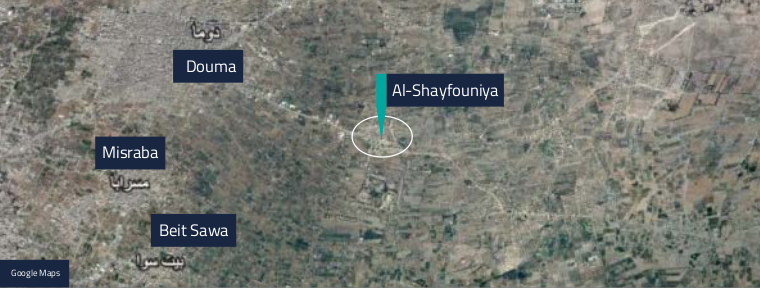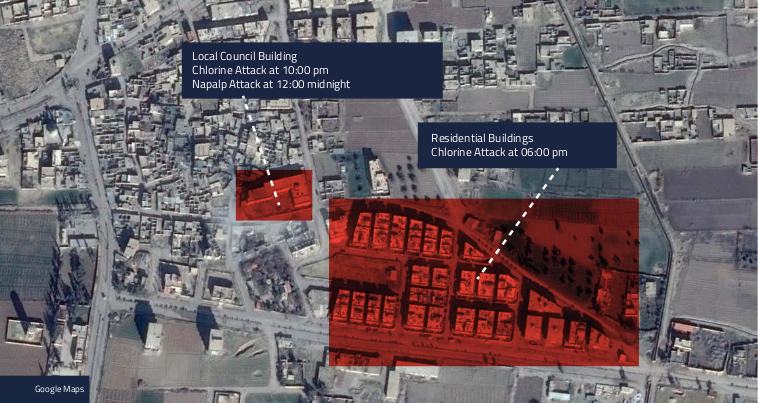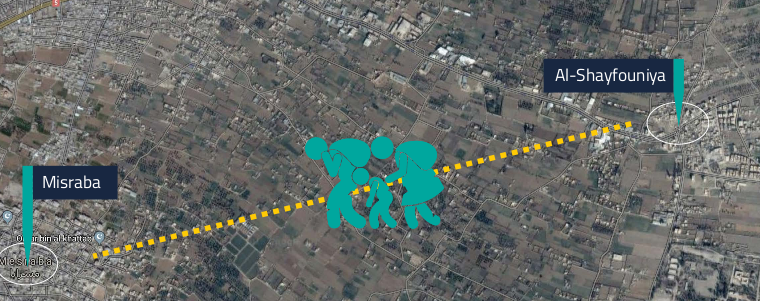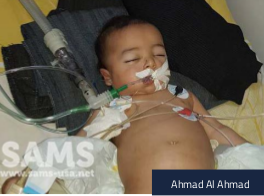
Possible Chlorine and Napalm Attacks on the Town of AlShayfouniya in Eastern Ghouta
If you want to download the report in PDF format, Please click here
Summary:
Evidence provided to the Violations Documentation Center (VDC) indicates that Syrian warplanes launched several raids on the town of Al-Shayfouniya in Eastern Ghouta, using rocket-propelled grenades suspected to be loaded with chlorine gas on residential areas in the town. The attack was followed by a raid on the same town with what is highly suspected to be Russian fighter jets. The fighter jets launched rocket-propelled grenades loaded with incendiary materials that directly targeted the building of the local council in the town and resulted in the death of six civilians who were seeking shelter from the continuous bombing in the basement of the building. 72 hours after the raid, town residents found charred bodies in the basement of the building. They could not carry the bodies outside and bury them because large parts of the bodies turned into crisp ashes.
The VDC recorded the death of three children as a result of suffocation from chlorine gas. The father of one of these children was unable to bury his son immediately after his death due to the intensity of the warplane raids and their targeting of moving objects. He carried the body of the son and took shelter in the basement of the local council building in the town of Al-Shayfouniya. He was also later killed by burning napalm rockets, and along with his son, turned into two charred bodies that were later found in the area.
Methodology:

Al-Shayfouniya is a small town with 2500-3000 inhabitants and is located southeast of the city of Douma in Eastern Ghouta.
The VDC has collected data and information, as well as conducted testimonies and interviews with local residents that include medical personnel, ambulance crews and rescuers. The VDC conducted a comprehensive analysis of the data collected directly or with the assistance of the “Committee for Monitoring Violations in Eastern Ghouta”. The witnesses who were interviewed separately were cross checked by the VDC’s staff in East Ghouta or by the monitoring body. The VDC also used maps provided by Google Earth and all relevant information to cross check the locations of the raids and events mentioned in the various testimonies. The names of witnesses cited in this report have been changed for their safety.
It is difficult to verify the suspected chemical use in the military attacks without laboratory tests. However, the marks, smells and symptoms cited by witnesses and doctors point to the use of chlorine gas by Syrian government forces in Al-Shayfouniya area. The marks left by some shells on the site and the bodies of the victims indicate a likely use of incendiary napalm.
This report uses only data that the VDC has been able to verify. All other data has been kept and may be used later if it is verified.
Context:
From February 18, 2018, Syrian government forces and allied armed militias, supported by the Russian Air Force, have carried out an unprecedented military offensive on the Eastern Ghouta of Damascus. The Syrian government gradually lost control of the area from January 2012 to November 2012, and has not had any official access to the area since then.
From the end of 2012, Eastern Ghouta has been subjected to a total siege by Syrian government forces. No food or medical supplies entered the area with the exception of intermittent assistance through the UN Office for the Coordination of Humanitarian Affairs in Damascus.
Today, the area is under the control of two armed opposition factions, Jaysh Al-Islam and Faylaq al-Rahman, and there is a limited presence of gunmen from the Hay’at Tahrir al- Sham. Jaysh Al-Islam and Faylaq Al-Rahman joined a de-escalation agreement that came into effect in May 2017 for six months, and which could be extended with Turkish, Iranian and Russian guarantees.
On 24 February 2018, the Security Council adopted Resolution 2401 that demanded a ceasefire and the entry of humanitarian assistance to areas in need in Syria. The VDC noted through the daily monitoring of violations that Resolution 2401 was in no way reflected in the cessation or reduction of recent military escalation.
Deliberated Coordination of the Attacks:
The data and information collected and analysed by the VDC indicates the possibility that attacks were based on a deliberated scheme primarily intended to inflict as much damage as possible on the civilian population of the town of Al-Shayfouniya:
- On 19 February 2018, Al-Marj Hospital was targeted with missiles directed from a Syrian warplane in two batches. The hospital was again targeted with two barrel bombs on February 24, 2018. The hospital went out of service completely after that. Barrel bombs are indiscriminate weapons that cause intense damage on the areas they fall upon.
- On February 22, 2018, Syrian warplanes began intensive raids, during which barrel bombs were used.
- The main roads were destroyed, preventing any rescue teams or ambulance crews from nearby areas and towns from reaching Al-Shayfouniya. The inhabitants were forced to take shelter in basements and shelters.
- The missiles targeted moving objects, in addition to drinking water reservoirs and food warehouses.
- On 25 February 2018, warplanes are suspected to have dropped several rounds of chlorine gas, causing suffocation of residents in basements and shelters. The residents were forced to flee under bombardment to the nearby towns of Misraba and Douma.
- Warplanes are suspected of using flaming napalm shells that burned all those present at the site.
Hell on Earth:
Majid (pseudonym) is a 24-year-old university student. He described the beginning of the intensive military attack on the town of Al-Shayfouniya to the VDC:
“On February 18, 2018, a military campaign began and encompassed heavy raids on our town, but as of 22 February 2018, the campaign intensified even more and targeted the town on that day with five bursts of rocket launchers that fired tens of rockets on residential areas and buildings. A large number of barrel bombs exploded above everything in Al-Shayfouniya. And the reconnaissance planes did not leave the sky during the whole time. And every moving object was a target and not even stranded animals were spared.”
Abdelhamid (pseudonym) is a 49-year-old from Al-Shayfouniya and a member of the local council of the town. He testified to the VDC: “On February 22, 2018, we counted a total of 42 air strikes in just one hour. Since the Syrian government lost control of the town, Al-Shayfouniya had not been hit by barrel bombs with the exception of one time in 2014. While the aircraft in this recent campaign launched more than 50 barrel bombs in just three days. Residents are now refugees in basements, without drinking water and adequate food, with only the small quantities that were distributed by the local council of the town. They did not have access to a toilet and human waste spread everywhere.”
“On February 25, we were in a basement that was about 200 meters from the local council building. We were drinking contaminated water because the raids destroyed all the drinking water tanks in the town,” Majid said. “At 10pm, I decided to take the risk of moving towards the local council basement because no food had reached the families in our basement since 6pm the day before. When I arrived I saw more than 20 families in a basement area of about 100 square meters.”

Death Is Everywhere and No Time for Burial:
“Shortly after my arrival to the local council’s basement, a father arrived carrying his 5-years-old son who appeared to be a dead corpse,” says Majed, the former witness. “Someone there used what’s left of the water, nearly half-liter, to wash the child’s face, and then he poured what’s left in his mouth”.
Talal (pseudonym) from Al-Shayfouniya, who is a member of the local council, indicated to the Violations Documentation Center that he tried to perform CPR to save the child, Mohammed Shihab:
“We had only half a bottle of water. I poured water on his face and put some water in his mouth and then pressed on his chest. The child exhaled discharging the water that came out of his mouth loaded with the smell of chlorine. I immediately realized that the child had died”.
Abdul Hamid, a former witness, describes how he saw the child, Mohammed Shihab: “The constant bombardment did not allow us to bury him. His father remained holding his body and hiding with us inside the basement waiting for the violent waves of bombardment to stop to be able to bury his child.”
From One Hell to Another
Majed remembering some close moments to death:
“Shortly after I arrived at the local council building, a shell fell nearby but did not explode. Yet, it produced a continuous sound like the sound of leaking air coming out of a narrow opening. Then the smell of chlorine spread out everywhere. We were lucky because the shell fell outside and the natural winds kept the gas density away from the families’ whereabouts.”
Talal (former witness), answering our question on about how he knew that the shells were loaded with chlorine gas, said: “Primarily, from the smell of gas. Secondly, from the way the shell fell; it did not explode and only a light continuous sound of leaking preceded the spread the strong chlorine smell”.
Majed continues recounting the story of his departure:
“We agreed after an urgent discussion that the situation is very bad and there is no possibility for the continuous presence of families in the basements. So, we decided to escape through the agricultural road towards the town of Misraba.
At 11:30am, just before the midnight of February 25, we began the difficult journey. We had a lot of children, wounded, and old people amongst us and we were targeted by five mortars till our arrival.
On our way out we were watching the continuous air raids over the Al-Shayfouniya and the local council building. Then, we saw the glow of a large fire followed by the sound of a huge explosion. Finally, we arrived to Misraba at four o’clock in the morning. Then, at six we have been informed that the basement of the local council in Al-Shayfouniya had been targeted by napalm bombs.”
“We contacted the civil defence, who said that they could not enter the town because of the bad roads and the targeting of any moving bodies on the ground, even animals. I went with several other people into the town at night through the agricultural roads. Outside, I saw drinking water tanks that were the size of a large room and had been reduced to small plastic blocks. When we entered the basement of the council, we saw six charred bodies and the fire was still burning some of their limbs. We could not lift the bodies out of place because they began to crumble and were no longer a single block. I used a shovel to try to put the bodies into sacks but I fell apart in front of the horror of the scene of the shattered corpses of my relatives and friends. We could not immediately identify the each body. We knew some of them from the metal section of their waist belt or from their keychain. The body of Khalid Shihab had been turned into ashes, next to the ashes of the body of his young son, Mohammed Shihab, who had died before from chlorine gas. Today, February 29, three days have passed, and the bodies remain in the same place. ”
Doctor A. T. told the VDC that the bodies found in Al-Shayfouniya after the night of February 26 were “completely charred and their bones crumpled. These people were burned and their bodies remained as though they were just hit by the napalm shell.”

The Death of a Third Child after Several Days:

Dr. Mohammed Katoub of SAMS Medical Center, who resides in Turkey and receives daily urgent reports from SAMS hospitals in the Eastern Ghouta, has indicated to (VDC) that: “The child Ahmed Al-Ahmad from the town of Al-Shayfouniya was 10 months old and had arrived at one of the SAMS hospitals in Eastern Ghouta on Sunday, February 25, 2018. He was diagnosed with respiratory failure accompanied with other symptoms of chlorine inhalation. Then, he died on Thursday, March 1, 2018.”
The VDC had recorded earlier the death of another victim Adnan al-Samoudi, a 4- year- old from the town of Al-Shayfouniya, who suffocated after having inhaled the chlorine gas immediately after the first bombardment of the town at around 6 pm on February 25, 2018.
Adnan al-Samoudi – 4 years old
The International Humanitarian Law IHL prohibits; however, Syria always seems to have its own international law!
The Chemical Weapons Convention (CWC) signed by the Syrian government in September 2013 prohibits the use of toxic chemicals, such as chlorine, to kill or injure. Furthermore, international humanitarian law and the laws of war applied to Syria also prohibit the use of chemical weapons and consider the use of prohibited weapons with criminal intent, intentionally or recklessly, to be a war crime.
The Syrian government has ignored the calls to join to the Protocol III, which prohibits the use of incendiary weapons from the air on civilian populations. Russia, however, like all other permanent members of the Security Council, is a member state in the Protocol. Protocol III defines “civilian gatherings” as “any gathering of civilians, whether permanent or temporary, such as inhabited parts of cities, towns or populated villages, camps, queues of refugees or evacuees.”
The attacks described in this report have followed the adoption of the Security Council resolution number 2401, which clearly requires all parties to declare a 30-day humanitarian truce and to allow the delivery of emergency humanitarian assistance to the besieged areas. However, the attacks mentioned in this report have all been launched after the issuance of the resolution which clearly indicates the Syrian and Russian governments’ lack of commitment to the UN truce.
The VDC calls on the United Nations, the Security Council, the Human Rights Council and the Office of Humanitarian Affairs to seriously consider these violations of UN resolutions, international law and the CWC. Furthermore, the VDC calls to open an independent international investigation to consider the recurrence of these violations and to take all necessary steps to protect civilians in Syria and to provide them with all needed assistance in their places of residence.


